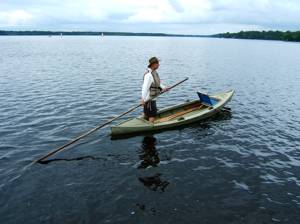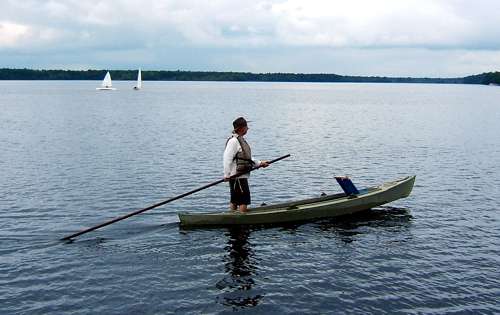Railbird Skiffs |
|||||
|---|---|---|---|---|---|
|
|||||
|
In the Delaware River Chapter of the Traditional Small Craft Association, there are lots of shiny, beamy, fast sailboats, all different. You almost never see a boat that is like anyother boat in the fleet. But in one corner of the beach is always one boat that is more different than most. It is painted flat camouflage green and is long, low, and skinny, 15 ½ feet long by 4 ½ feet wide. It’s a local boat, You can tell it was built for a purpose. It wasn’t built to go fast or to ride out storms at sea or to land in surf. It is a railbird skiff, and it was designed and built to hunt for railbirds. “Why would you want to hunt railbirds?” you might ask. They are tiny, and to hide in the reeds they stick their beaks straight up in the air so they look like stalks of grass. But this is the Delaware, and people used to do funny things around Delaware. Some of them live in Philadelphia, others live in New Jersey, that gives you the idea. The first thing to know about railbird skiffs is how they travel. You don’t paddle them much, and you don’t row them much. You stand on a little afterdeck and push them along with a skinny pole that is longer than the boat. Poling is a logical way to travel around skinny water with lots of weeds. Rowing or paddling don’t work too well there, the blades get stuck. You can pole yourself along pretty well where there isn’t much water; And that describes a lot of the Delaware River Basin. Now, poling is pretty simple, and you are standing, so you can easily see where you are going, even in tall grass; we all can see how to do it,and it appears to be a calming exercise. But there is one rule you must know from the first. You can be going along fine, but if there is a soft spot in the mud you are using as your purchase, the mud will grab the pole. You will suddenly discover that the boat is still moving, and the pole isn’t. It is time for you to choose. “The boat or the pole” . Lesson number one is to choose the boat, not the pole. Many a waterman has found himself hanging from a pole while the boat quietly drifts away. You look very silly that way. |
|||||
| The railbird skiff is not as sophisticated as an Adirondack Guide Boat; no portage, so it doesn’t have to be as light. It is build of our lovely local cedar, or sometimes called juniper. So it is light and strong, and very resistant to rot. But a railbird skiff serves the same function, a boat for a guide and hunter, but the guide is in the back and the hunter in the front. We have a railbird skiff in our local chapter of the TSCA. It is a favorite “borrow” boat at all our outings. You quickly learn the graceful rhythm of poling it along the waterfront. Plant the pole by sliding it along through your fingers, then lean into the push for power, then pull smoothly for the recovery. Tom Shephard takes care of it, but it isn’t exactly his. Somehow long ago it transferred to the club from the Independence Seaport Museum. |  |
||||
Photo: Andy Slavinskas |
|||||
| The Workshop on the Water had built five of them, years ago when the shop was on a barge moored in the Delaware River. Tom ended up with one of the five, but, if his wife asks who owns the boat, it is always some other member’s boat; Tom just takes care of it. We have several boats in the Charter’s fleet whose ownership just kind of evolved. There are many boats in our chapter’s fleet, and cars that spend the night in the garage are quite rare. My garage hasn’t seen a car in the ten years we have lived here. | |||||

